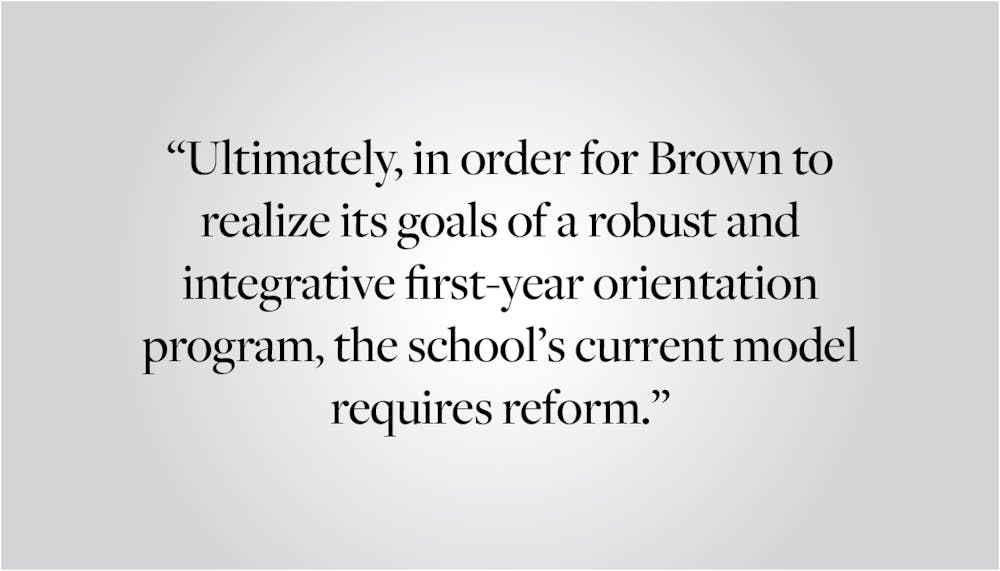As trees begin to bloom, professors assign final exams and the last remnants of A Day on College Hill are cleared away, it’s time to think about how the University will welcome a new class of undergraduates to campus in the fall. Brown’s New Student Orientation is a long-standing tradition, but the past few years have brought serious disruptions to normal programming. The class of 2024 was confined to online school for much of the 2020-21 academic year, while a potential COVID-19 surge loomed large over fall 2021 orientation. The fall 2022 semester presented new students with the first “normal” introduction to campus in several years.
Brown faculty recognized the value of orientation by voting to permanently extend programming by two days in 2022, noting that pre-COVID-19 orientation also didn’t do enough to adequately transition first-years onto campus. The orientation Welcoming Committee acknowledged some of these failings last fall when it introduced new offerings such as Target takeovers and Rhode Island School of Design Museum tours to orientation. But it’s time to look at broader aspects of orientation with a fresh perspective: As Brown prepares for the arrival of the class of 2027, it must reform its programming to more proactively meet the needs of new students.
When planning out its programming, the University should remember what orientation is supposed to accomplish: acclimating first-year students to campus. According to Brown’s website, this includes exposing students to the “history, traditions and values of our community,” as well as “facilitating connections” with peers and providing information about the open curriculum. In other words, orientation is critical to setting up first-years’ academic and social journeys at Brown for the next four years, and we have a few suggestions on how this mission can be accomplished.
Because many orientation activities are organized by residence hall groups, there are few structured opportunities for students to meet peers outside of their dorm, leaving first-years oddly segmented as they get to know one another. But in order to facilitate connection, orientation has to be about exposing students to the greatest number of people on campus and increasing students’ chances of meeting other first-years that they may be most compatible with. Following the first two days of orientation, Brown should diversify its orientation groups by putting students in new, randomized groups for the remainder of orientation.
Additionally, because so many of Brown’s current orientation offerings are optional, students may be weary of participating in events without having the certainty that others will also be in attendance. A little more structure could go a long way in improving the experience of orientation, which is why Brown should make all orientation programming mandatory. While some might argue that forcing students to do activities may make orientation less enjoyable, the benefits of fostering an involved and tight-knit community are worth it. Ultimately, if students are going through mandatory programming together, they will almost definitely bond — even if it is over how much they want to get out of an activity.
Meiklejohn Peer Advisors should also have a stronger presence in orientation to improve students’ academic transitions to the University. Given the freedom surrounding Brown’s open curriculum, incoming students should be receiving ample mentorship and support regarding registration, concentrations and class selection. During orientation, Meiklejohns typically meet with their peer advisees on advising day. But Brown should leverage orientation’s recent extension to ensure peer advisors connect with mentees earlier before the semester and can give personalized feedback on the overwhelming experience of registering for classes.
Finally, universities such as Princeton, Dartmouth, Yale, Columbia and Tufts University all offer peer-led, outdoor trips in their freshman orientation programs. Wilderness trips can be formative, intimate experiences where students bond with one another. Integrating something similar into Brown’s New Student Orientation would not only give students the chance to explore scenic locations in the greater New England area but also help students foster deep connections with their peers.
First impressions are everything, and making these foundational changes to orientation programming could be instrumental in shifting students’ satisfaction with Brown for years to come.
Editorials are written by The Herald’s editorial page board and aim to contribute informed opinions to campus debates while remaining mindful of the group’s past stances. The editorial page board and its views are separate from The Herald’s newsroom and the 133rd Editorial Board, which leads the paper. This editorial was written by the editorial page board’s editor Kate Waisel ’24 and members Yasmeen Gaber ’23, Tom Li ’26, Jackson McGough ’23, Alissa Simon ’25 and Yael Wellisch ’26.





